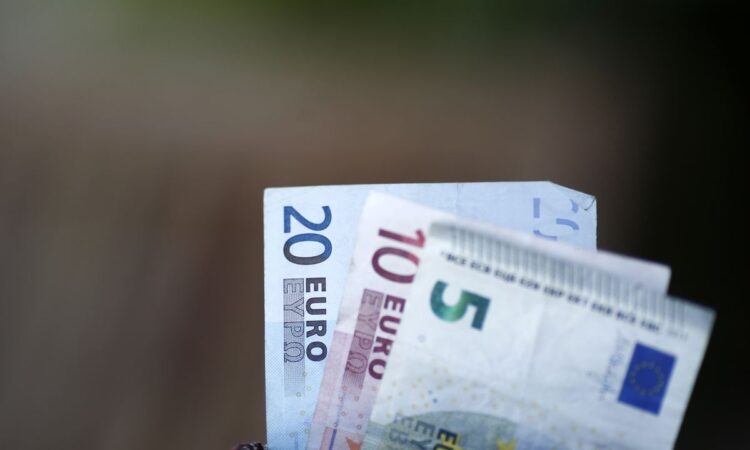
The euro has continued to fall against the dollar for the eighth consecutive week. The single currency has lost more than 5% of its value since mid-July, and is now worth $1.07. The magnitude of its decline can be understood by observing what has happened in recent times, when the European currency rarely moved below $1.10. An exceptional drop in value occurred almost a year ago, when the dollar surpassed the euro for the first time in 20 years. Now, with the specter of recession looming over the Club of Twenty, the euro has become a reflection of the economy that relies on it, and its gap with the United States is widening.
While Europe is still struggling to subdue inflation, which has not fallen below the 5% barrier for months, the United States, where price increases are around 3%, seems to have the situation more under control. That has carried over to the race to hike interest rates: analysts expect a pause from the Federal Reserve (the Fed), but have more reservations about what the European Central Bank (ECB) will do.
Attempts to cool the economy by raising the price of money have set the pace of the currency battle, in which the dollar has the upper hand. A year ago, while Washington began to move to stop the rise in prices that began during the pandemic, the ECB downplayed the dangers and called the situation temporary. Jerome Powell, president of the Fed, announced the first increase in March 2022, while in Frankfurt, the ECB, with Christine Lagarde at the helm, only did so four months later.
For the expert on the political situation and world economy at IE University, Juan Carlos Martínez, this slight advantage was an important boost for the dollar to revalue itself in most markets ahead of the euro. The decision caused a joint depreciation of key currencies in international trade; among others, the British pound, the Chinese yuan, the Japanese yen and the euro. And although the latter has maintained a higher value than the dollar over the last twelve months, the days when the euro was exchanged for $1.59 are long gone. At that time, it was not uncommon to find European tourists traveling to the United States with empty suitcases to fill them with low-priced purchases by taking advantage of the generous exchange rate.
How do you appreciate a currency?
Under normal conditions, when central banks raise interest rates, the local currency increases in value on the foreign exchange market because government and corporate bonds become more attractive, in turn attracting more investors seeking a hig yield. However, unlike the United States, Europe has not managed to return to “normal conditions” in the last 12 months. Beset by the Russian invasion of Ukraine and hit by the grain crisis and a worsening drought in the south of the continent, the region is struggling to stimulate economic growth. Brussels predicts that growth for 2023 will be only 0.8%.
In the United States the scenario is different. Despite its slight contraction in August, the American labor market has been surprisingly strong. Consumption figures are robust and salaries have risen above inflation. The positive data will force the Fed to discuss whether there is room to raise rates above the current 5.25% at its meeting next week, which would strengthen the currency and further depreciate the euro. Santiago Carbó, a business analyst at the Spanish analysis center Funcas, maintains that “we are not going to see a weak dollar until the American market shows signs of weakness or the markets discount that the Fed has ended its rate hike.” He concludes that this could happen before the end of the year.
The ghost of recession
Although the labor market in Europe remains robust, with an unemployment rate at historic lows of 6.4%, inflation in the region is higher than in the United States, especially if the prices of food, services, and non-energy industrial goods are taken into account, which still average around 5.5%. Martínez believes that Europe will not be able to begin its recovery unless these decrease to normal levels. Add to this that the price of a barrel of Brent crude oil, which shot up to $90 this week, threatens to cause new inflationary spikes.
Under this framework, the specter of recession is beginning to scare investors and experts more and more. They estimate that the ECB will pause before continuing with the increases. The president of the German IFO institute, Clemens Fuest, believes that the body, which meets this Thursday, should wait to see if the economy weakens further and if inflation falls before making any decision. Failure to do so could put economies like Germany’s against the wall — it grew only 0.1% in the second quarter of this year, after a brief technical recession, and could fall 0.4% in 2023, according to the data from the European Commission.
The winners and losers
Europe pays for the energy products it imports in dollars, so its rise in prices affects the most dependent countries, such as Spain, which pays more for the gas and oil it needs. Consumers also lose out because this increase is passed on to consumers via energy prices.
Although it is not all bad news for the euro. Thanks to the devaluation of the currency, European exports have become more competitive on the foreign market because they are sold cheaper without affecting producers’ margins, and European companies obtain more euros by repatriating profits or receiving dividends from their foreign subsidiaries. Furthermore, countries that use the euro become more attractive for non-EU tourists, because they receive more euros in exchange for their local currencies, which makes their stay cheaper.
Sign up for our weekly newsletter to get more English-language news coverage from EL PAÍS USA Edition



